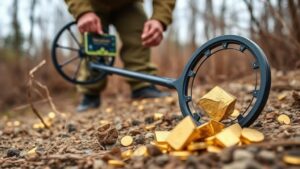Using Vegetation Patterns to Detect Hidden Placer Deposits
Using Vegetation Patterns to Detect Hidden Placer Deposits
The detection of concealed placer deposits, which are accumulations of valuable minerals formed through geological processes, presents a significant challenge for geologists and mineral exploration experts. Recent advancements in the understanding of biogeochemical signaling have introduced the potential for using vegetation patterns as a tool for locating these deposits. This article explores the concepts and methodologies involved in utilizing vegetation indicators to uncover hidden placer deposits, offering insights into the mechanisms behind this innovative approach.
The Relationship Between Vegetation and Minerals
Plants interact with their environment in complex ways, absorbing various nutrients and elements from the soil. e processes can lead to noticeable changes in plant health and distribution patterns. In areas where placer deposits are present, the mineral content and subsequent mineralization of the soil can influence vegetation characteristics. For example:
- Plants growing above gold deposits may exhibit stunted growth or discoloration due to the toxicity of certain metals.
- On the other hand, some plants may hyperaccumulate metals, indicating a high presence of mineral deposits in the soil.
Such plant responses to subsurface mineral content provide a link between vegetation patterns and the likelihood of hidden placer deposits, making it possible to use these indicators for effective exploration.
Biogeochemical Methods in Exploration
Biogeochemical methods involve the analysis of plant samples to identify trace elements and minerals accumulated within their tissues. following steps outline the typical biogeochemical exploration process:
- Sampling: Collect plant samples from various locations, particularly those exhibiting unique growth patterns.
- Elemental Analysis: Use advanced techniques, such as inductively coupled plasma mass spectrometry (ICP-MS), to analyze the samples for metal concentrations.
- Data Interpretation: Correlate the elemental composition of plants with geological data to identify potential locations of placer deposits.
Through these biogeochemical assessments, researchers have successfully identified mineral-rich areas that traditional exploration methods may have overlooked.
Case Studies: Successful Applications
Several real-world applications demonstrate the effectiveness of using vegetation patterns to detect hidden placer deposits. One such case occurred in British Columbia, Canada, where researchers conducted a study on the relationship between vegetation and gold deposits:
The team analyzed various plant species in areas with known gold placer deposits and identified significant gold concentrations in the tissue of specific plants. By mapping these concentrations, they pinpointed exploration sites that ultimately yielded substantial gold recoveries, validating the predictive power of vegetation patterns.
Another example can be seen in the Australian outback, where remote vegetation mapping integrated with soil sampling led to the discovery of previously unexplored areas enriched with heavy minerals, including gold and precious metals. This successful integration of biogeochemical methods showcased the potential for increased exploration efficiency in vast regions of rugged terrain.
Challenges and Considerations
Although the use of vegetation patterns for detecting hidden placer deposits offers many advantages, challenges remain, including:
- Environmental Variability: Soil conditions, climate, and other environmental factors can influence vegetation patterns, complicating data interpretation.
- Species-Specific Response: Some species may react differently to mineral presence, necessitating a comprehensive understanding of local flora.
- Cost and Complexity: Advanced analytical techniques can be expensive and require specialized knowledge, potentially limiting accessibility for smaller exploration firms.
Addressing these challenges requires an interdisciplinary approach combining botany, geology, and analytical chemistry to effectively harness the potential of vegetation patterns in mineral exploration.
Actionable Takeaways
In light of the information presented, here are some actionable takeaways for geologists and mineral exploration professionals:
- Integrate biogeochemical analysis of vegetation into traditional exploration methodologies to enhance discovery rates of hidden placer deposits.
- Invest in training and resources to utilize advanced analytical technologies that can support elemental analysis of plant samples.
- Develop collaborations between botanists and geologists to improve understanding of plant responses to mineralization, which can refine exploration strategies.
By leveraging vegetation patterns in the detection of hidden placer deposits, professionals can uncover new mineral resources while contributing to more sustainable exploration practices.



